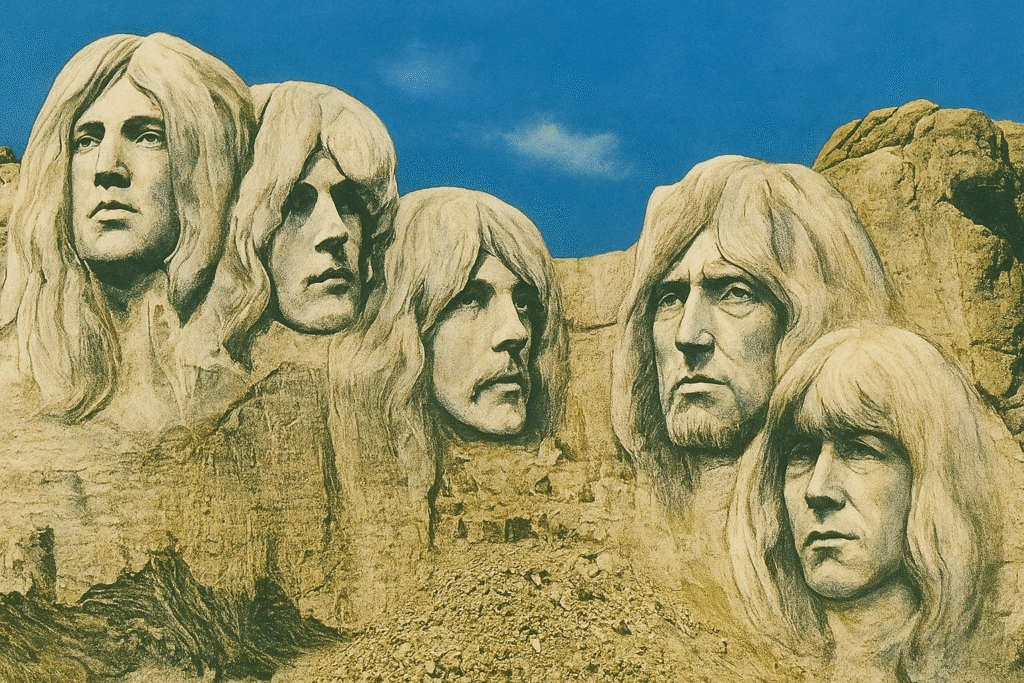
AI-generated image for illustrative purposes.
In 1970, rock was living through its psychedelic hangover. The hippie movement no longer carried the same conviction, and young people wanted something rawer, more aggressive. It was in this climate that Deep Purple released In Rock, the album that carved the band’s name into the pantheon of hard rock. No exaggeration: this record is a founding landmark, an electric scream that rivaled directly with the weight of Black Sabbath and the grandeur of Led Zeppelin.
Historical Context: The Birth of a Monster
After three albums with modest commercial impact and plenty of experimentation, Purple finally struck the lineup that would change everything: Ian Gillan (vocals) and Roger Glover (bass) joined Ritchie Blackmore, Jon Lord, and Ian Paice. The result was a chemistry of technical arrogance and sonic brutality. While Sabbath dove into the occult and Zeppelin into heavy blues, Purple chose noisy virtuosity. The stage was no place for peace and love — it was an arena for musical gladiators.
Track by Track: A Listening Guide
Speed King
An uncompromising opener: chaotic distortion, Gillan’s screams tearing through the ears, and a wild duel between Jon Lord’s Hammond organ and Blackmore’s guitar. The lyrics play with nods to ’50s rock classics, but the sound is pure ’70s demolition. The title doesn’t lie: the speed was nearly unheard of for its time, influencing future generations of metal.
Bloodsucker
With razor-sharp riffs and a heavy groove, this track shows Purple on the offensive. Gillan spits the words with venom while Glover and Paice keep the rhythm crushing. The Hammond organ blares like a warning siren, creating constant tension. It’s straightforward — but maliciously energetic.
Child in Time
The masterpiece of the album. Ten minutes that start slow, almost innocent, before transforming into a hysterical assault of vocals and guitars. Gillan reaches highs so extreme they border on the surreal. Blackmore crafts a dramatic, almost classical solo that erupts in catharsis. Inspired by the Cold War climate, it’s a sonic metaphor for nuclear tension. Many call it Purple’s “Stairway to Heaven,” but in truth, it’s a one-of-a-kind apocalyptic hymn.
Flight of the Rat
Nearly eight minutes of pure stamina. Here Purple proves they could jam long and still keep the intensity burning. The riff races ahead and Paice’s drums sound like a runaway train. One of the album’s most underrated moments — a track that could easily have laid the groundwork for speed metal years later.
Into the Fire
Heavy, repetitive, and hypnotic. The riff is simple but hammers like a metallic mantra. Gillan swings between aggression and melody, delivering a track that feels like a prototype for the stripped-down metal of the ’80s. No frills here — just brute force.
Living Wreck
Less remembered, but revealing: Purple shows they could balance groove and heaviness. The dragging riff feels dark, almost poisonous, while Gillan sings with biting cynicism. A track that widens the album’s palette, giving breath between speed and grandeur.
Hard Lovin’ Man
The closer is a futuristic blow. Velocity, circular riffs, frenetic keyboards — everything pointing beyond traditional hard rock. Many critics consider it a forerunner of thrash, such is its urgency and aggression. Ending the record with this punch was a clear statement: Purple wanted to be remembered as the loudest band in England.
Production and Aesthetic
Recorded in London, In Rock was the first album with the classic lineup. Its deliberately raw sound captured the violence of their live shows. The cover, parodying Mount Rushmore with the band members carved in stone, was pure mockery and megalomania. They weren’t asking permission to join rock’s pantheon — they were chiseling themselves in by force.
Reception and Legacy
Up until 1970, Deep Purple was seen as promising but far from mass success. The first three albums had earned modest critical notice and limited sales. With In Rock, the explosion came: the record hit the UK top 5, turned shows into packed arenas, and cemented the band as a global giant. Today, it is remembered as one of the founding pillars of hard rock and heavy metal. Without it, the path of dozens of bands — from Iron Maiden to Metallica — would have been very different.
Conclusion: Eternal Fire
In Rock is not an album for timid listening. It is a sonic assault, built to irritate neighbors, teachers, and critics. Half a century later, it still burns with the same intensity. If Sabbath brought dark heaviness and Zeppelin mysticism, Purple brought virtuoso arrogance. And that set the ’70s ablaze.
Burning Questions
Was In Rock the commercial turning point for Deep Purple?
Yes. It was the record that elevated them from a promising act to stadium giants.
Is “Child in Time” overblown or genius?
It’s both — and that very excess is what turned it into a masterpiece.
Why is Deep Purple cited less often than Sabbath or Zeppelin?
Because their career was marked by more commercial ups and downs. But sonically, In Rock is as decisive as the classics of those other two bands.
Does the album still sound relevant today?
Absolutely. Tracks like “Hard Lovin’ Man” were already anticipating the extremity of metal that wouldn’t fully arrive until years later.
By Marcus Whitmore
